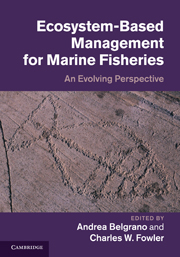Book contents
- Frontmatter
- Contents
- List of contributors
- Foreword
- Acknowledgments for cover artwork
- Introduction
- PART I CURRENT FORMS OF MANAGEMENT
- PART II ELEMENTS OF IMPORTANCE TO MANAGEMENT
- 5 Unintended consequences sneak in the back door: making wise use of regulations in fisheries management
- 6 Population dynamic theory as an essential tool for models in fisheries
- 7 Recovery of former fish productivity: philopatric behaviors put depleted stocks in an unforeseen deadlock
- 8 Boundary shifts: from management to engagement in complexities of ecosystems and social contexts
- 9 Civil society and ecosystem-based fisheries management: traditional roles and future opportunities
- PART III USING PATTERNS
- Afterword
- Index
- Plate section
7 - Recovery of former fish productivity: philopatric behaviors put depleted stocks in an unforeseen deadlock
from PART II - ELEMENTS OF IMPORTANCE TO MANAGEMENT
Published online by Cambridge University Press: 17 February 2011
- Frontmatter
- Contents
- List of contributors
- Foreword
- Acknowledgments for cover artwork
- Introduction
- PART I CURRENT FORMS OF MANAGEMENT
- PART II ELEMENTS OF IMPORTANCE TO MANAGEMENT
- 5 Unintended consequences sneak in the back door: making wise use of regulations in fisheries management
- 6 Population dynamic theory as an essential tool for models in fisheries
- 7 Recovery of former fish productivity: philopatric behaviors put depleted stocks in an unforeseen deadlock
- 8 Boundary shifts: from management to engagement in complexities of ecosystems and social contexts
- 9 Civil society and ecosystem-based fisheries management: traditional roles and future opportunities
- PART III USING PATTERNS
- Afterword
- Index
- Plate section
Summary
An attempt has been made to determine the spawning areas of the principal fish, plaice, herring, cod, haddock, to define the spawning migrations, the nurseries where the young fish develop, etc. It is hoped it may in this way be possible to find the general laws for the appearance of biological groups …
Johan Hjort (1926)Abstract
It is widely recognized that knowledge of population structure and connectivity is vital for sustainable use of the world's marine fisheries resources. The harvest of each individual population unit should ideally be managed to account for its specific level of productivity directly. Whereas most emphasis has been placed on identifying discrete population units, much less effort has been given to the mechanisms behind stock separation. Evidence is accumulating to indicate that philopatric behaviors (stock-specific behaviors) are important, in this regard, not only in other kinds of species, but also in marine free-spawning fish species. Recent studies on herring and cod in the waters bounded by Norway, Sweden, and Denmark (Skagerrak–Kattegat) indicate that philopatric behavior is a key factor in shaping stock structure. Under such circumstances, an area depleted of its stock components can only slowly be repopulated by fish from adjacent areas. Repopulation, for example, may depend on adults successfully aggregating and reproducing at new locations, with new migratory patterns that are dependent on new behavior. This can be a very time-consuming process, and the slow formation of new viable populations units results in a bleak forecast for population recovery.
- Type
- Chapter
- Information
- Ecosystem Based Management for Marine FisheriesAn Evolving Perspective, pp. 232 - 247Publisher: Cambridge University PressPrint publication year: 2011



